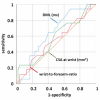Electrodiagnostic Testing and Nerve Ultrasound of the Carpal Tunnel in Patients with Type 2 Diabetes
- PMID: 35743445
- PMCID: PMC9225449
- DOI: 10.3390/jcm11123374
Electrodiagnostic Testing and Nerve Ultrasound of the Carpal Tunnel in Patients with Type 2 Diabetes
Abstract
In diabetic patients, controversies still exist about the validity of electrodiagnostic and nerve ultrasound diagnosis for carpal tunnel syndrome (CTS). We analyzed 69 patients with type 2 diabetes. Nerve conduction studies and peripheral nerve ultrasound of the median nerve over the carpal tunnel were performed. CTS symptoms were assessed using the Boston Carpal Tunnel Questionnaire. Polyneuropathy was assessed using the Neuropathy Symptom Score and the Neuropathy Disability Score. Although 19 patients reported predominantly mild CTS symptoms, 37 patients met the electrophysiological diagnosis criteria for CTS, and six patients were classified as severe or extremely severe. The sonographic cross-sectional area (CSA) of the median nerve at the wrist was larger than 12 mm2 in 45 patients (65.2%), and the wrist-to-forearm-ratio was larger than 1.4 in 61 patients (88.4%). Receiver operating characteristic analysis showed that neither the distal motor latency, the median nerve CSA, nor the wrist-to-forearm-ratio could distinguish between patients with and without CTS symptoms. Diagnosis of CTS in diabetic patients should primarily be based upon typical clinical symptoms and signs. Results of electrodiagnostic testing and nerve ultrasound have to be interpreted with caution and additional factors have to be considered especially polyneuropathy, but also body mass index and hyperglycemia.
Keywords: carpal tunnel syndrome; diabetes mellitus; nerve conduction study; peripheral nerve ultrasound.
Conflict of interest statement
The authors declare no conflict of interest. The funders had no role in the design of the study; in the collection, analyses, or interpretation of data; in the writing of the manuscript, or in the decision to publish the results.
Figures





Similar articles
-
Characteristics of diabetic and non-diabetic carpal tunnel syndrome in terms of clinical, electrophysiological, and Sonographic features: a cross-sectional study.BMC Musculoskelet Disord. 2023 Sep 16;24(1):739. doi: 10.1186/s12891-023-06881-1. BMC Musculoskelet Disord. 2023. PMID: 37716949 Free PMC article.
-
Dexamethasone versus Hyaluronidase as an Adjuvant to Local Anesthetics in the Ultrasound-guided Hydrodissection of the Median Nerve for the Treatment of Carpal Tunnel Syndrome Patients.Anesth Essays Res. 2019 Jul-Sep;13(3):417-422. doi: 10.4103/aer.AER_104_19. Anesth Essays Res. 2019. PMID: 31602055 Free PMC article.
-
Severity of Carpal tunnel syndrome assessed with high frequency ultrasonography.Rheumatol Int. 2010 Apr;30(6):761-5. doi: 10.1007/s00296-009-1061-x. Epub 2009 Jul 11. Rheumatol Int. 2010. PMID: 19593567
-
Grey-scale sonography and sonoelastography for diagnosing carpal tunnel syndrome.World J Radiol. 2016 Mar 28;8(3):281-7. doi: 10.4329/wjr.v8.i3.281. World J Radiol. 2016. PMID: 27027498 Free PMC article. Review.
-
The role of diagnostic ultrasound in the examination of carpal tunnel syndrome: an update and systematic review.J Hand Ther. 2022 Apr-Jun;35(2):215-225. doi: 10.1016/j.jht.2021.04.014. Epub 2021 Apr 14. J Hand Ther. 2022. PMID: 34261588
Cited by
-
The role of neuromuscular ultrasound in diagnostics of peripheral neuropathies induced by cytostatic agents or immunotherapies.Acta Neuropathol Commun. 2023 Nov 27;11(1):187. doi: 10.1186/s40478-023-01685-9. Acta Neuropathol Commun. 2023. PMID: 38012771 Free PMC article.
-
Clinical Utility of Boston-CTS and Six-Item CTS Questionnaires in Carpal Tunnel Syndrome Associated with Diabetic Polyneuropathy.Diagnostics (Basel). 2022 Dec 20;13(1):4. doi: 10.3390/diagnostics13010004. Diagnostics (Basel). 2022. PMID: 36611296 Free PMC article.
-
Diagnostic Accuracy of Neuromuscular Ultrasound vs. Electrodiagnostic Studies for Carpal Tunnel Syndrome: Systematic Review and Meta-analysis of Paired Accuracy Studies.Hand (N Y). 2024 Sep 26:15589447241278972. doi: 10.1177/15589447241278972. Online ahead of print. Hand (N Y). 2024. PMID: 39324685 Free PMC article. Review.
-
Prevalence of carpal tunnel syndrome in patients with long-term type 2 diabetes mellitus.Heliyon. 2022 Dec 22;8(12):e12615. doi: 10.1016/j.heliyon.2022.e12615. eCollection 2022 Dec. Heliyon. 2022. PMID: 36593820 Free PMC article.
-
Characteristics of diabetic and non-diabetic carpal tunnel syndrome in terms of clinical, electrophysiological, and Sonographic features: a cross-sectional study.BMC Musculoskelet Disord. 2023 Sep 16;24(1):739. doi: 10.1186/s12891-023-06881-1. BMC Musculoskelet Disord. 2023. PMID: 37716949 Free PMC article.
References
Grants and funding
LinkOut - more resources
Full Text Sources
Research Materials
Miscellaneous

